Winemakers who employ whole cluster fermentations (skipping the crushing/destemming step) do so for added complexity. The technique works better for some varieties than others, and brings risks, but those who believe in the benefits would have it no other way. Two pros who ferment wines 100% with whole clusters share their advice so home winemakers can reap the benefits too.

Blake Yarger is the Winemaker at Big Basin Vineyards in Boulder Creek, California.
We do a lot of whole cluster fermentation, including 100% with Pinot Noir, Syrah, Grenache, Mourvèdre, and Carignan. Generally, we use whole clusters to add tannin and aromatic compounds; increasing the textural and aromatic complexity of a wine. In Pinot Noir, the stems seem to provide precursors for floral aromas, which especially show up as it ages. In Syrah, whole cluster ferments seem to encourage more savory varietal characteristics.
Other red varieties may not see the same benefits from whole cluster fermentation. Bordeaux varieties are already high in tannin and green aromas (pyrazines), so whole cluster ferments have less potential benefit and more risk of producing hard, green wines. We usually destem Bordeaux varieties, while occasionally using whole clusters in the 5–20% range.
For some varietals, the stems are surprisingly flavor-neutral but add an important textural component. If the whole clusters are appropriately ripe, the tannins may still be firm and chewy in the wine’s youth but will soften and become more complex with time in bottle. Egg white fining can be a useful tool in combination with whole cluster. We like the added aromatic complexity and tannin that whole clusters add, and a gentle egg white fining can resolve any overly firm tannins that might have come from the stems.
In my experience, beyond the impact on tannins, flavors, and aromas, whole clusters have a slight de-acidifying effect. Whole cluster fermentations will result in a wine that has a higher pH and lower titratable acidity than a destemmed fermentation of the same fruit. This can be either a good or bad thing, depending on the chemistry of your must. In our hydraulic basket press, whole clusters also allow for better yields at lower pressures. The stems seem to provide pathways for the juice to escape the press cake more efficiently and at lower pressures.
For lots that will be fermented as whole clusters, we want to see good lignification of the peduncle and little to no sap flow when the cluster is cut from the vine. If these two conditions are not met, it is much more likely that whole clusters will impart green aromas and tannins to the wine. Proper crop load management, dry farming, and deficit irrigation are important practices to also consider in farming fruit for whole cluster use.
With our equipment, all fermentations with stems included are through whole clusters. If home winemakers have trouble pressing fruit that has not been crushed, I think crushing and destemming fruit and then adding some of the stems back is an interesting practice worth exploring. The stems could potentially be left to dry for a day or two, which might allow them to further lignify and reduce the chance of any green aromas getting into the wine. They could even be kept in a mesh bag and pulled from the fermentation whenever the winemaker has gotten the desired result.

Michael Bacus is the Owner/Winemaker of Bacus Vineyards in Newberg, Oregon.
We have been doing whole cluster fermentations on some of our Pinot Noirs for the last few years. In 2021, our Wadenswil clone was made using 35% clusters for whole cluster fermentation and in 2022 we used Pinot Noir 777 using 100% of the clusters for whole cluster fermentation. We used some carbonic maceration in both cases to keep the cap moist as the wine was fermenting. We switched to 777 due to the aroma-enhancing characteristics of this Pinot Noir clone.
The most noticeable difference in these whole cluster wines is the fruit amplification in the flavor and the aroma. Whole cluster fermentation causes the juices to ferment inside the berries. As the grape cell needs energy to live, it cannibalizes the sugars inside the berry, much like yeast does, producing alcohol as a waste byproduct. When the percentage of alcohol in the berry reaches ~2%, the grapes burst and feed additional nutrients to the yeast. This process leaches anthocyanins from the skin into the pulp and accentuates the fruit flavor of the grape and reduces tannin in the resulting wine. Whole cluster fermentation slows down the fermentation as not all the sugar is available to yeast at the beginning of the fermentation, resulting in a longer, slower, cooler fermentation. This has an impact on the flavor and aroma, and ultimately the overall structure of the wine. Because 80% of a wine’s flavor is based on aroma/sense of smell, we believe that the longer, slower fermentation helps draw out esters that develop a better aromatic composition of the wine than a faster fermentation provides.
The decision on stem inclusion is based on the health of the clusters and stems in the vineyard. You can chew stems on harvest and get a rough idea of what impact the stem tannins will have on the finished wine. I look for a peppery spice flavor and green, healthy stems. I think, although I have not experienced this personally, that if the stems are not fully ripe you can get off-flavors such as vegetal green notes. We had a freeze during budbreak in 2022 that pushed harvest back until mid-October. The grapes and the stems were fully ripe, had no detectable green notes, and had the flavor profile we were looking for, including subtle hints of spicy nutmeg, peppercorns, cinnamon, cigar box-type flavors. This led us to go 100% whole cluster as it seemed like the perfect year to do it.
The technique is all about finding balance. Stem inclusion increases pH, body perception, and weight. Due to the increase in pH, the stem tannins are discerned as softer, resulting in a longer and smoother finish as the wine ages.
Tannins help a wine age, and inclusion of stem tannin in Pinot Noir compensates for the reduction in tannin from the whole cluster fermentation and helps in storing and aging. The stem tannins are used to reinforce the tannin structure to balance out the amplification of the fruit flavors and add a peppery/spicy finish to the wine that I find very palatable. This produces a lighter/fruitier Beaujolais-style Pinot Noir. We find that our red wine-drinking customers enjoy a lighter, less tannic red in the summer.
Whole cluster wine is typically a lighter shade of red, more of a ruby/claret colored wine. This is because it inhibits the ability of wine to absorb color/anthocyanins. If I had to guess, I’d say our whole cluster fermented Pinot is about a 10% lighter hue than our crushed/destemmed Pinot Noirs. Everyone’s palate is different — I’d say customers split 50/50 on preferring the whole cluster Pinot versus traditional Pinot Noir.
If you don’t want to do a whole cluster fermentation but still want to include some stems, I think it would be an interesting experiment to try adding stems back into the fermenter. I don’t see any problem with a home winemaker trying this, but I think it’s the combination of the slower, longer fermentation from the whole cluster process that gives the juice the opportunity to extract what the stems have to offer. I would expect adding stems into a destemmed grape ferment to not be as impactful, but it could still add interesting flavors.







